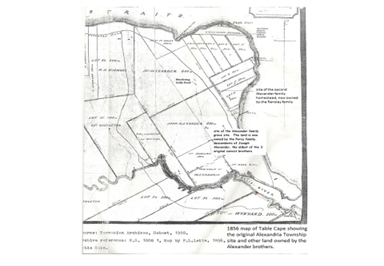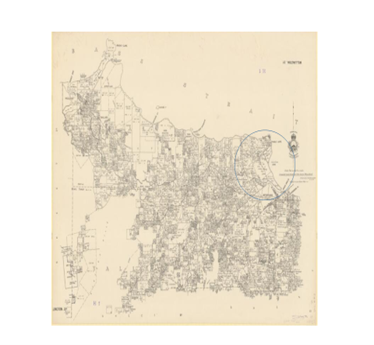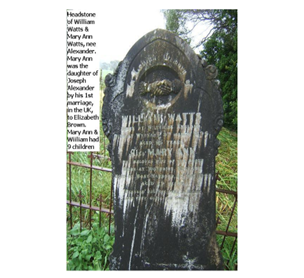Part 4 (continued)
By Derek Smith
Correction to previous articles:
In my original submission to ITM I stated that Alexander Terrace in Stanley was named after Joseph Alexander, FM’s grand uncle. Prior to moving to Wynyard in 1860 Joseph and his family lived in Stanley and had considerable property interests so I made a tentative guess that the Terrace was named after him. I contacted the local Council and was told it was ‘very probably’, named after him. I took that as a confirmation.
My error. I should have checked further at the time but didn’t.
Now that I have looked into it further, Alexander Terrace was named after Henry Alexander, a Director of the Van Diemens Land Co., based in London. John Lee Archer, a renowned architect and engineer at the time who helped developed the Stanley town site when it was first established, named the Terrace after the Director. Alexander Street, an important street in Burnie, is also named after Henry.
So the naming of Alexander Creek, running through Joseph’s property in Upper Burnie, may also be called into question. However, I can find no alternative source for the name, it’s a very small creek and, given its small size and relatively minor importance to anyone other than Joseph and his family, it is hard to believe that Henry Alexander was the source. Unlikely but not impossible. I will stay with Joseph being the naming source, at this time.
On another topic, Alexander House in Burnie, connected to the Alexander family since its construction and currently owned by members of the Dowling family, is up for sale. When it is sold it’s likely that the connection to the extended Alexander family will finish. Probably inevitable, nothing lasts forever, but a little sad.
Also, major works are happening at Somerset, where another bridge is being constructed adjacent to the current bridge. The new bridge edges closer to the Old Ferry Inn that was, for a while, home to FM’s grandmother Maria Lewis, formerly Brown, nee Davis and her second husband Captain Thomas Lewis. The house site is now surrounded by a large car yard with the new bridge nearby. Difficult to reconcile today with pictures 25 and 26 in the Jackie Evans book.
When I talked with a friend about the changes happening, with new replacing old, he reminded me of a quote from one of the Discworld books written by the late Sir Terry Pratchett.
‘If you keep looking at the past you’re facing the wrong way for the future’. An uncomfortable but timely reminder.
To recap, twenty years had elapsed since the arrival of the first (and second) of the Alexander brothers as convicts, and the purchase or lease of Table Cape land. One year after the two brothers were transported, the third brother, John, arrived.
In those twenty years Joseph remained married to Elizabeth in England and had two surviving children. Matthias had become a widower and father of six surviving children. John had been widowed twice and was the father of three surviving children. They had established lives in the Deloraine area. Now their lives would start again on Table Cape.
The twice widowed John and his partner Mary Ann had just returned from America and, in 1852, the recently widowed Matthias decided to try his hand in the Australian goldfields. Clearly, the adventurous spirit was strong in both John and Matthias!


Matthias, on his return from the goldfields some months later, joined John at Table Cape where they began to clear the land and began to build the township of Alexandria. By 1856 the Alexanders had a large land holding on the Cape. (see Fig. 15).
Of interest here is the large landholding for Joseph Alexander. His connection with Table Cape is minimal. He may have been there for a short while but soon left to go to Stanley in the Circular Head area. He owned and managed what was then the Emily Hotel and is now the Stanley Hotel and had substantial number of smaller properties in the area which he rented out, so it seems he had chosen to make his life there. Yet he is shown as having a large landholding on the Cape. Clearly he was a man of means, with a level of wealth that a life in England would not have produced. Like his brothers, life in the Colony had been good for him.
Another minor mystery here. Where is a landholding for Matthias on Table Cape? The 1856 map does not show a property for Matthias. Perhaps his gold mining trip was not that successful, or he was happy with his 500 acres holding near Deloraine?
Yet there is a record of him growing 3000 bushels of wheat ‘on part of his land’ which suggests that he could claim ownership of something.
Perhaps the whole Alexander landholding on the Cape was a shared ownership between the brothers, yet John and Joseph are the only owner names on the map? Or perhaps Matthias worked Joseph’s block? He is usually associated with the Table Cape Inn at the Alexandria town-ship, though John held the licence there. Whatever the situation at that time, it was Matthias’ descendants who worked the Cape until the land began to be sold in the early 1900s, so the Matthias line must have obtained ownership at some point.
By 1919 most of the land holding had been sold. (see Fig. 16). The circled area is the area covered by the map in Fig. 15.
However, another small point of interest, it does show a different entrepreneurial direction for John Alexander. The land holding by Sister’s Creek, toward the western end of the Cape, is the site of a slate quarry he owned and worked successfully for a while, employing staff. I suppose it could be said that, as a quarry owner, he was still ‘working the land’, but it was not quite the traditional farming the Alexanders were used to.
John had died in 1898, some 20 years before the map was printed, yet he is still shown as the owner. And there are other land holdings shown as owned by his brother Joseph, who died 40 years before the date on this map.
In those early years on Table Cape the three Alexanders brothers are together for a while, but by 1854 Joseph had moved to Stanley where he became a publican, shop keeper and landlord. They all prospered. It would seem that as well as having important practical skills for life in their new home, they all had a strong entrepreneurial flare.
In 1854 all the brothers remarried. Matthias married Ann Eden Thewlis, a niece of Mary Ann Thewlis, partner of John. In 1855 they started their family and within the ten years before the death of Matthias, there were seven children. Two died in infancy and one died young.
John married his partner Mary Ann Thewlis and there were no children.
Joseph, as already mentioned, married Mary Dyer, who died childless within 17 months of the marriage. In 1856 Joseph married Harriet Gee in a ceremony at Table Cape but they returned to Stanley soon after. Eleven months later they had started their family with the arrival of the first of their three children. The last daughter, Henrietta (Harriet), was born in 1862 after Joseph and Harriet decided to move back to Table Cape.
In all, the brothers married eight times and there were sixteen surviving children. Joseph had married Elizabeth Brown in England at the time of his transportation, and they had three children, Josiah, Elisha and Mary Ann. Joseph’s transportation left his wife and children in a difficult position, dependent on the support of their families. However Irvine writes of a letter from Elizabeth to Joseph, in which she says ‘… in answer to your questions, we are all well and the children are going to school … ’. ‘Elizabeth had a small shopkeeping business and maintained their three children that way’ (41). This suggests that life may have been hard but they were not destitute, unlike the wives of some other Swing Riot transportees.
Elisha lived until 1909 but, sadly, died in the Hungerford Workhouse and, as mentioned, Josiah died of typhus in 1849. There are anecdotal accounts about descendants of Elisha and Josiah beginning Alexander family lines in Wales and Canada.
The third child was Mary Ann (Ann) Alexander. Following the death of her mother Elizabeth in 1855, Mary Ann decided to join her father in Van Diemen’s Land. Perhaps she had heard that he was doing well or, more likely, life in rural England as a woman with limited means of support, was not a pleasing prospect? Perhaps Joseph managed to get some money to her to and she used it to finance her journey? Whatever the reason, it was a brave decision and she must be seen as another example of the pioneering spirit of the Alexanders.
In 1856 she arrived, as a free settler, on the ship Donald McKay, together with two brothers Thomas & William Watts. She found her father in Stanley where, it is reported, she received a rather frosty reception from Joseph’s new wife Harriet. Perhaps Harriet was not comfortable with the fact that this new arrival – her step-daughter – was five years older than her!
We must assume that Mary Ann married Thomas Watts as, by June of 1857 they had their first child. Another child was to follow in 1859 but, sadly, a few days before the birth, Thomas died, of ‘a brain disease’. The following year Mary Ann married William, Thomas’s brother and went on to have nine more children. Mary Ann would become the matriarch of the Watts branch of the Alexander family tree, second in size to the Alexanders.
William and Mary Ann are buried at Flowerdale with the headstone still standing. (see Fig. 17).
A small point of interest here. Mary Ann was born in 1830, before her father was convicted for his role in the Swing Riots. Could this mean that she could say she was not the daughter of a convict? She also travelled here as a free settler and her children were fathered by free settlers. If so, the whole Watts line on the family tree could also claim ‘free settler’ status rather than ‘convict’ status.

Nowadays there is some pride taken in convict ancestry but in Mary Ann’s time, convict ancestry was not as socially acceptable and it is possible that she would have found it more advantageous to claim free settler status and avoid, what was then, the stigma of convict forebears.
To be continued (with one more instalment!) in the next issue…
References
41. Irvine H , op cit p. 21-22
Illustrations
Fig. 15. 1856 Lette map of Table Cape
Fig. 16. 1919 map of Table Cape
Fig. 17. Headstone Mary and William Watts
Note from author: Family research is not an exact process. Records disappear, or are wrongly recorded, newspaper accounts are less than accurate, and so on. This account represents aspects of the Alexander family history that I have put together from many sources. If there are errors, and with family research that is always a possibility, they are down to me. If anyone has any information that either supports or disputes what I have written, please get in touch. Information shared is knowledge gained. My particular thanks to the Alexander family in Tasmania for their help, in particular the late Ken Alexander and his daughter Sue for access to their family information.
